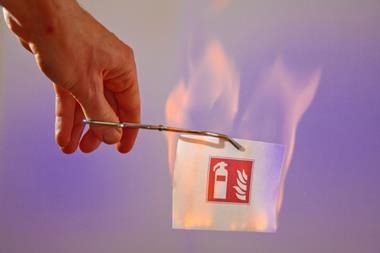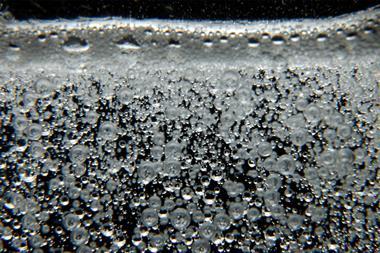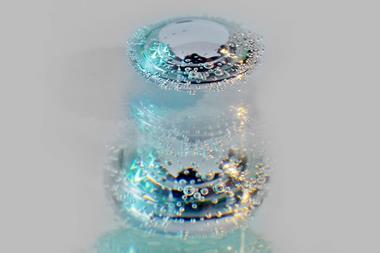From a thermodynamic perspective, endothermic processes are fighting an uphill battle. So while it’s easy to find plenty of dramatic demonstrations of exothermic reactions, most endothermic reactions don’t leave much of an impression.
However, a dramatic impression might be needed to shake the misconception some students hold that endothermic reactions cannot occur spontaneously. This is where the solid–solid reactions of barium hydroxide with ammonium salts are useful. Here I describe two. The thiocyanate reaction works much faster and is my preferred method, but the chloride salt is more widely stocked and thermodynamic data for it is easier to find.

Kit
- Eye protection
- Two 100 cm3 beakers
- Stirring rod
- Barium hydroxide-8-water, c.32 g (corrosive)
- Either ammonium thiocyanate, c.15 g (harmful) or ammonium chloride, c.11 g (irritant)
- Universal indicator (or red litmus) paper, 1 strip
- Watch glass or small wooden block with one side of similar size to the base of the beaker
- Thermometer that reads to –30°C or lower
Preparation
Weigh out the solids in separate beakers. Stand the beaker containing the barium hydroxide in a watch glass containing a few drops of water, or on a wooden block with a few drops of water on top. You want good contact between the base of the beaker and the water.
In front of the audience
Work in a well-ventilated room or a fume cupboard. Take an initial reading of the temperatures of the two beakers and point out the liquid water on which the barium hydroxide beaker is standing. A digital thermometer that can be connected to a display or digital infrared thermometer can be useful here.
Add the ammonium salt and mix the powders with the stirring rod. The temperature will rapidly drop to approximately –20°C, the water on the base freezes causing the watch glass or wooden block to freeze to the flask. In the case of the thiocyanate reaction, the solids dissolve in barium hydroxide’s water of crystallisation. Damp red litmus held over the top of the flask turns blue to reveal the presence of ammonia vapour – take care not to inhale the toxic vapour.
Once the production of ammonia has stopped, the beaker can be passed around the class, taking care to ensure the watch glass is removed first or that it is supported from underneath.
Teaching goal
This demonstration complements the sodium acetate ‘hot ice’ stalagmite demonstration1 when first introducing the idea of exothermic and endothermic reactions. The sodium acetate demonstration shows how a solid forming from a liquid is a process that involves bond formation and so must be exothermic. Emphasising the exothermicity of bond formation is important because of the common misconception held by students of the reverse being true.
In the reaction of barium hydroxide with ammonium thiocyanate, the opposite happens – a liquid (as well as ammonia vapour) forms from a solid and the contrast with the hot ice demonstration can reaffirm the connection between bond breaking and endothermic processes.
As the reaction finishes, an opportunity presents itself to keep another misconception in check and shore up students’ conceptions of conservation of energy. It’s worth asking what will happen to the temperature of the cold mixture and why. How many students will explain this process using concept of ‘cold’ spreading out rather than heat energy from the surroundings being absorbed until thermal equilibrium is reached? A misconception probe for 14–16 year-olds on thermodynamic topics related to this demonstration is available.2
| ΔHf (kJ mol–1) | S (J K–1 mol–1) | ΔGf (kJ mol–1) | |
| Ba(OH)2.8H2 O(s) |
–3342 |
427 |
–2793 |
|---|---|---|---|
| NH4 Cl(s) |
–314 |
95 |
–203 |
| BaCl2.2H2 O(s) |
–1460 |
203 |
–1297 |
| NH3 (aq) |
–80 |
111 |
–27 |
| H2 O(l) |
–286 |
70 |
–237 |
The reaction for ammonium chloride is usually written as follows:
Ba(OH)2.8H2 O(s) + 2NH4 Cl(s) → BaCl2.2H2 O(s) + 2NH3 (aq) + 8H2 O(l)
If showing this reaction to older students, they can use thermodynamic data to predict whether the reaction should to be spontaneous.3
Based on the data in table 1, the reaction will have a ΔH of +62 kJ mol–1, a ΔS of +368 J K–1 mol–1 and a ΔG of –48 kJ mol–1, indicating the reaction is endothermic and spontaneous due to the large, positive ΔS.
Downloads available for this article
- Technician notes as a pdf or MS Word file
- PowerPoint slides
Safety and disposal
Wear eye protection. All waste can be disposed of down the sink with plenty of water.
Downloads
Chilling effects powerpoint slides
PowerPoint, Size 0.56 mbChilling effects technicians notes
Word, Size 81.5 kbChilling effects technicians notes
PDF, Size 68.48 kb
References
- Education in Chemistry, July 2013, p13 (Hydrogen peroxide decomposition using different catalysts)
- See task 3 in Strengthening teaching and learning of energy: misconceptions and teaching models, p8. Department for Education, 2009 (bit.ly/2e7Jyi9, part 1, p27)
- B Z Shakhashiri, Chemical demonstrations: a handbook for teachers of chemistry, volume 1. University of Wisconsin Press, 1983 (amzn.to/2dOoYmV)



















1 Reader's comment